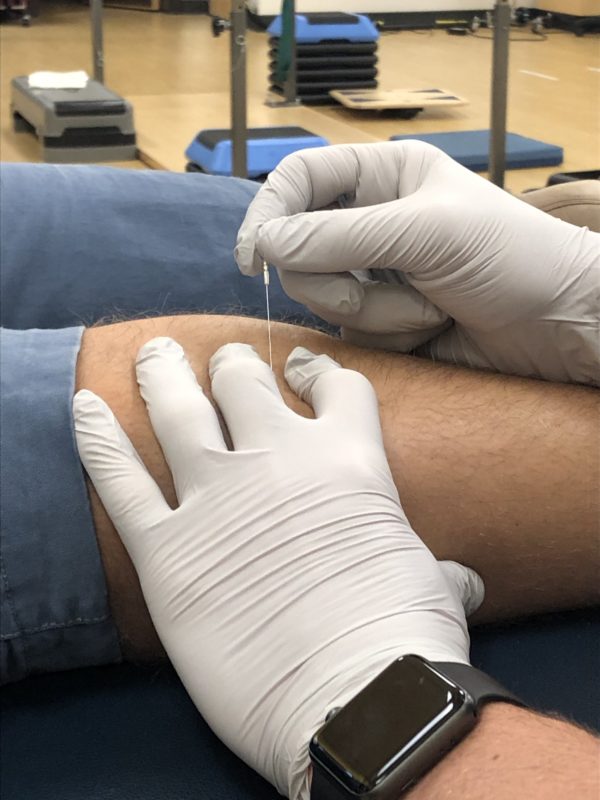When the physical therapy team at Sanford Health Watertown (South Dakota) Clinic mentions “cupping” and “dry needling” as possible ways of helping a patient, there may be a pause followed by a quizzical look.
Then physical therapists like Chrystelle Vail and Casey Grimsrud will explain what they are talking about.
Theresa Hartman of Watertown listened to Vail tell her about cupping. She liked what she heard.
“To be honest, I was willing to try anything,” Hartman said. “I was in that much pain.”
Hartman had lower back problems, though she wasn’t sure why. All she knew for sure was that she was in extreme discomfort. That pain kept her from working and from doing much of anything.
It got to the point where she could not sit down without the aid of medication. After exhausting other potential treatments, she had a conversation with Vail, who suggested cupping.
Learn more: Physical therapy at Sanford Health
“She said, ‘Let’s try this,’” Hartman said. “It was really something. I could feel the improvement right away. She asked me about the pain level, and I said, ‘I don’t know exactly what you did to me, but I really like it.’”
Hartman, who works in construction cleanup, was able to get back to that detail full time. She started out at three sessions a week with Vail and is now down to one a week.
Cupping, explained
So how does this work?
Cupping involves applying suction to an affected area that then decompresses muscles and connective tissue. By doing so, it can increase blood flow, accelerating the body’s own healing process.
It has been around for thousands of years, though it got a boost from Michael Phelps at the 2016 Olympics. The legendary swimmer competed with purple circles on his back caused by cupping. He cited it as a way of alleviating the pain of sore muscles.
As Vail can tell you — and her patients can attest — it’s not just for Olympic swimmers. In ancient times, people used clay bowls and open flame to create the suction required, but therapists in Watertown use a Rocktape brand product made of silicone that uses a pump to decompress affected areas without using heat.
“This model is really adamant about incorporating movement with all of the treatment sessions,” Vail said. “Movement leads to healing. It is reprogramming that neurosensory pathway to the brain. So it is helping to teach patients correct forms of movement to help decrease their pain in the future as well.”
It can be an effective alternative to break up restrictions in the muscles. Sometimes soft-tissue movement can be painful because the targeted area is particularly sensitive. It can be an option, then, because it involves decompression rather than compression.
“I’ve not had a hard time convincing people that it might help them,” Vail said. “Most people are on board with it. It’s another way to massage an area and create that soft-tissue mobilization.”
Dry needling, explained
It is natural for potential patients to want to understand the pros and cons before trying a new treatment. That is why Grimsrud, in his capacity as a physical therapist who offers dry needling, understands it is a procedure that often calls for some explaining.
Dry needling is not acupuncture, though it does involve the same kinds of monofilament needles.
“Acupuncture is based on Eastern medicine,” Grimsrud said. “Dry needling is based on Western medicine.”

In dry needling, the needles are inserted into trigger points in the muscles that can restore normal function. Among its potential advantages is that it is used to treat both short-term and long-term pain without the use of medications or surgical procedures.
“It’s something that can get you over the hurdle and can then help you restore normal function,” Grimsrud said. “Let’s say you’re in a lot of pain and you can’t do a lot of movement. It’s a tool to minimize that pain so that you can get back to normal function and can work on your strength.”
Getting moving
It is not an end-all, be-all, Grimsrud said, but it can play a significant role in getting people back to where they can access conventional therapies.
“It can help you manage the pain that is keeping you from getting moving again,” Grimsrud said. “That’s the main thing — we want people to be able to move and get through a day.”
Dry needling has become increasingly popular in the United States in the past decade, though it was not licensed in South Dakota until August 2018.
Shortly after, Grimsrud and Sanford Watertown Clinic began offering it as part of their therapy services. It’s also available from sports physical therapists at Sanford Sports in Sioux Falls.
“Previously, some people in our community from around here were going to Minnesota for dry needling because it was allowed there,” Grimsrud said. “This has been shown to be beneficial for people. It’s why we’re doing what we’re doing.”
The clinic has a staff of three physical therapists and a speech therapist on their team, offering an integrated health system that includes a wide range of physical therapy.
That package includes cupping and dry needling, a pair of increasingly popular treatments. Those suffering from muscle pain are encouraged to contact a local physical therapist to learn more.
Learn more
- Back and neck pain causes and cures: Podcast
- Chiropractors work with physicians to reduce patient pain
- Pain management services at Sanford Health
…
Posted In Rehabilitation & Therapy, Sanford Sports, Sioux Falls, Symptom Management, Watertown